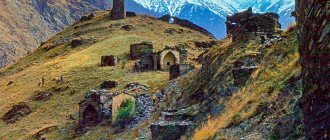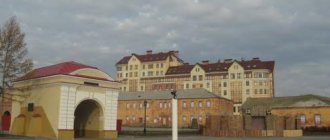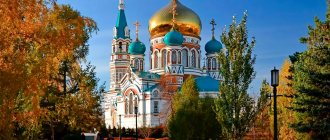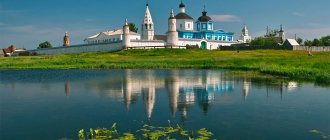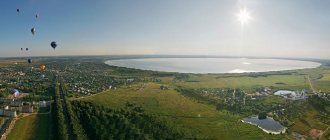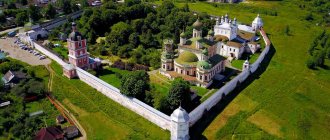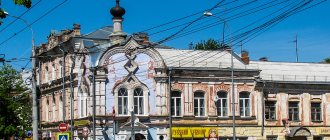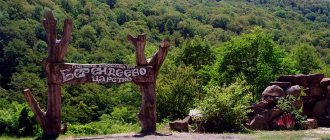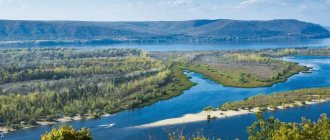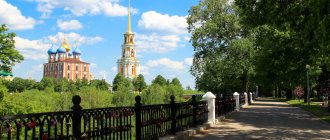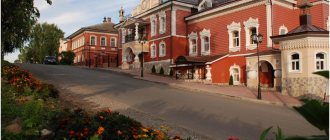Murom is an ancient city, the first mention of which is found in the Tale of Bygone Years and dates back to the 9th century. In the 14th century it became a major merchant and industrial center and trade hub, supported by river transport routes on the Oka River.
Despite the abundance of significant monuments of Orthodox architecture, Murom was a late entry into the Golden Ring of Russia, since several large defense enterprises were located on its territory.
In human memory, the city is associated with the name of the epic hero Ilya Muromets, who was born in the vicinity of the city, the village of Karacharovo, as well as with the names of Peter and Fevronia, Orthodox patrons of family, fidelity and love.
A complete list of all interesting places near Murom or on the way to it is in the article about the entire Vladimir region and in the review of the nearest cities of the Golden Ring.
The incredibly interesting ancient Nizhny Novgorod is just 2.5 hours by car from Murom. A little further, but no less exciting, is Arzamas and its churches.
It’s also worth stopping by here if you are planning a visit to Vladimir and Suzdal - buses run regularly from Vladimir to Murom (2.5 hours on the way)
Monument to Peter and Fevronia
Address: On the peasant's square. Near the entrance to the Holy Annunciation Monastery (monastery address: Krasnoarmeyskaya St., 17A)
Since 2012, citizens and tourists can see Saints Peter and Fevronia cast in bronze. It is customary to bring daisies to the monument as symbols of marital love and fidelity. It was these flowers, according to legend, that grew on the joint grave of Peter and Fevronia.
The monument to the family's patron saints, like many other monuments, can make wishes come true: at the feet of Peter and Fevronia sits a small domestic rabbit. The rabbit needs to be rubbed - it brings long-awaited love and happiness to the house.
In good weather, newlyweds line up at the monument: they all want to give flowers to the dean prince and princess and pet the magic rabbit. This is a kind of marriage blessing ritual.
Annunciation Monastery and the miraculous Iveron Icon of the Mother of God
And next to the women's Holy Trinity Monastery, right across the road, is the men's Annunciation Monastery.
We were very interested in comparing these 2 places, which are located very close. It turned out that you experience different sensations inside.
This ancient monastery has its own saints and miraculous icons. And again it’s amazing: the relics (of princes Constantine, Mikhail and Theodore of Murom) rest in a single coffin.
The ancient miraculous icon of the Iveron Mother of God is also kept here. See details here.
Monument to Ilya Muromets
Address: Located in Oksky Park (formerly Lenin Park of Culture and Leisure) on the observation deck
A relatively new monument, which was erected in 1999 and is considered the second tallest monument in Russia after the sculpture of the Motherland in Volgograd. The height of the monument is 21 meters. He depicts the epic national hero in the form of a warrior-monk: under Ilya’s chain mail there is a robe hidden, and with his left hand he clutches an Orthodox cross.
Raising his sword, Ilya stands on the high bank of the Oka. The place was not chosen by chance - on the opposite bank the troops of the Bulgars and Polovtsians once gathered for an attack. It was here that the defense structures of Murom were located.
The monument symbolizes the military glory of the Russian people and the strength they showed in expanding their borders and protecting them.
Muromsky Bridge over the Oka River
The cable-stayed bridge across the Oka was built in 2009 in the southern part of Murom. Its characteristics are impressive: length - 1.4 km, width - 15 m, height of supports along the banks and in the middle - 85 m, carrying capacity - 5 thousand vehicles per day. According to the results of the All-Russian competition in 2013, the bridge was named the best in Russia. The Vladimir-Arzamas bypass highway passes over the bridge, bypassing Murom.
Muromsky Bridge over the Oka River
Epic stone
Address: Located on the side of the Vladimirskoye Highway, 150 meters after the entrance stele of Murom, opposite the Weather Station How to get there: If you enter the city along the Vladimirskoye Highway - 150 meters after the Murom stele on the right side of the road
The epic stone symbolizes the ancient shrine of the Slavs - the Alatyr stone, the progenitor of all stones. According to legends, Alatyr lies “in the sea-okiyan, on the island of Buyan,” and all the rivers of the world flow from under it. A kind of Yggdrasil from the world of stones - our ancestors revered boulders and endowed them with fateful power. Ilya Muromets came out to Alatyr, trying his luck, and made the right choice here.
Based on this legend, Murom architect Nikolai Bespalov brought part of it to life: The epic stone appeared on the road from Vladimir to Murom in 1967 and still lies there. The face of Ilya Muromets is imprinted on the stone and there is an inscription in Slavic script that mentions Murom from the Tale of Bygone Years.
Village Karacharovo
Address: Southern edge of the city, near Karacharovskaya street
There is not only real written evidence about the birth of the ancient Russian hero Ilya Muromets, but also evidence. All of them are preserved in the village of Karacharovo, the homeland of the folklore hero.
The hero's name was Ilya Ivanovich Gushchin, he was born in Karacharovo in the 13th century, in a small house that has been preserved to this day.
It is not known what the future hero did until he was thirty, but at thirty, according to legend, he went out to plow and began to uproot oak stumps with his hands. One of these stumps is in the Karacharovo Museum of Local Lore.
At the Trinity Church in the village of Karacharovo, a healing spring springs up. Local residents call it and similar springs “skoks”. It is believed that they killed Ilya Muromets's horse, Burushka, from the impact of the hooves.
The Trinity Church itself is of interest to lovers of rural church architecture of the 19th century. It is in a state close to disrepair, but still retains its beauty.
In the new temple of Karacharov, the church of Guria, Samon and Aviva built in 1993, a relic is kept - a particle of the relics of Ilya Muromets. From her they are blessed for military service.
Monument to V.K. Zvorykin
Murom is proud of another of its natives - an outstanding scientist, one of the inventors of television - Vladimir Zvorykin. In 2013, near a merchant's house on the current street. Pervomaiskaya, 4, where Zvorykin was born and lived until 1919, a monument was erected. The Zvorykins' house is now the main building of the Murom Historical and Art Museum.
Monument to V.K. Zvorykin
After the fall of the government that patronized him, Kolchak decided to stay in the USA, where he was on a scientific trip. In this country he became a world famous scientist. At the same time, Zworykin visited the USSR many times, and even thought about returning to his homeland. Despite the fact that Murom was a city closed to foreigners, in 1967 Zvorykin and his wife surprisingly easily visited their native places, simply arriving by taxi from Vladimir.
The monument depicts young Zvorykin as he was during the Murom period of his life. His gaze is directed into the distance, as if seeing world fame and constant longing for Russia.
Railway station building
Address: pl. Privokzalnaya, 5
For Muscovites, the view of the station building will remind them of the Kremlin wall. The association is not accidental: in 1912, the architect Shchusev, when designing the station building, deliberately planned and embodied this similarity. It was dictated by the solemnity of the moment: the completion of the construction of the station in Murom meant the launch of the new Moscow-Kazan railway.
In 1971, next to the station building, a model of the Ilya Muromets armored train was installed, the original of which was built on the initiative and with the money of Murom residents to participate in World War II. The Ilya Muromets train went through the entire war without tarnishing its glorious name.
Sudogodsky geyser (natural fountain). Homecoming
Our 3-day trip has come to an end. Almost everything planned was accomplished.
However, there was one point left in our program, which for some reason did not “yield” to us. We planned to visit a wonderful natural fountain on the way to Murom, not far from Sudogda. But neither the navigator nor the signs could help us find this secret place.
Therefore, I had to postpone visiting the Sudogodsky geyser until later. And now it has come: we are again passing by an amazing natural phenomenon. Will we be able to see this miracle, see here.
Oksky Park
Address: st. Pervomaiskaya, 8
Oksky Park, judging by the summary from the Vladimir Provincial News, was recognized by the townspeople as “charming” one hundred and sixty years ago, during its opening by Prince Trubetskoy. Residents admired the “illuminations” and beautiful alleys.
The oldest park in Russia is still a favorite vacation spot for Murom residents. Despite the fact that in the park there is no longer either the Kremlin, dismantled as unnecessary in the 17th century, or the Cathedral of the Nativity of the Virgin, the park is very beautiful and interesting to visit.
When walking through the park, you will walk along the Oka embankment, along alleys with landscape decorations, see the monument to Ilya Muromets and the observation deck of the city, located on the heights of the Kremlin Mountain.
Murom City Day 2013
And we would like to rest in the evening after the righteous day's work. But it was not there. Unexpectedly, it turned out that today, August 3, the city of Murom celebrates its birthday.
It was very interesting to see how they do it. Moreover, even outside the windows of our monastery hotel one could hear the music coming from the Oka embankment.
Read about what we saw and how Murom residents celebrate City Day here.
Murom Historical and Art Museum
Address: two buildings: st. Moskovskaya, 13 – exhibition center. st. Pervomaiskaya, 6 – Zvorykin house, art gallery Telephone: 8 (49234) 3-31-52 – order excursions 8 (49234) 3-62-34 – scientific and information department Website: https://www.museum-murom .ru/ Opening hours: Exhibition Center: 9:30 – 17:00; Thursdays 13:00 – 21:00 Art gallery: 9:30 – 17:00; on Saturdays 10:00 – 18:00 Cost: from 70 rubles. https://www.museum-murom.ru/base/uslugi-i-ceny
Since 1919, the largest museum in the Vladimir region has accumulated about one hundred thousand exhibits, located in exhibition halls and funds.
The museum is housed in two 19th-century buildings and consists of archaeological and art collections. The archaeological exhibits are especially noteworthy: the age of the city has made it possible to collect ancient household items, tools, jewelry, fragments of architecture, etc.
The museum displays permanent exhibitions:
- Russian art 17-19 centuries.
- Western European art 17-19 centuries.
- "Treasures of Ancient Murom"
- "City and Citizens"
- Archaeological collection of Count Uvarov
10-15 temporary exhibitions are shown throughout the year.
Where to go for a tourist in Murom: interesting places
Murom is not a popular tourist shopping destination. In terms of product range, this medium-sized city is inferior to neighboring regional centers. However, those who come to Murom for the weekend have somewhere to go shopping.
"Marmalade Murom"
The shopping center is located in a beautiful modern building. Inside there is a pizzeria, clothing, shoe, children's goods, and grocery stores.
Location: Kulikova, 7A, routes No. 7, 9, 13, 22 go past.
Visiting hours: 09:00-21:00.
Get directions
Cultural and entertainment
Inside the recreation center there is a nightclub of the same name, a restaurant with karaoke, bowling and billiards, a children's center and places with burgers and sushi.
Location: Vorovskogo, 24, routes No. 1, 2, 5, 6, 11, 12, 15, 16, 17, 20.
Visiting hours: from 10:00-24:00, and on weekends and holidays it may close later.
Get directions
Children's
Its employees offer various programs, including home-based programs: face painting, clowns, mafia, cat party, English.
Location: Karl Marx, 75, routes No. 7, 9, 13, 22.
Visiting hours: 10:00-20:00.
Get directions
Holy Trinity Convent
Address: Peasant Square, 3a Telephone: 8 (49234) 3-13-74, 3-04-41, 2-26-48
It was built of stone in the 17th century and has not changed since then, although it experienced hard times during Soviet times.
The main architectural accent of the ensemble is considered to be the Trinity Cathedral, made in the style of Russian patterns. The manual labor of blacksmiths and glazed tile masters was used to decorate the cathedral. Forged gold crosses and ornamental tiles gave the cathedral an airy appearance that distinguishes it from other cathedrals in Murom.
The main shrine of the monastery is the relics of Saints Peter and Fevronia. Pilgrims come to them asking for a happy marriage, love and fidelity.
The relics are in one coffin. According to legend, Peter and Fevronia, who took monastic vows, bequeathed to be buried together before their deaths, but this request was considered indecent, and their bodies were separated. Moans and crying were heard from underground until the graves were reunited. Since then, only one attempt has been made to separate the relics again: Peter was taken to a men's monastery, and Fevronia to a women's monastery.
The monks keep the memory of how their predecessors met Prince Peter wandering around the cathedral with his head down, and the nuns saw Fevronius wringing his hands. After the reunification of the relics, the visions stopped.
The Holy Trinity Convent is active, so women must have a scarf and a skirt to visit.
Temples and monasteries of Murom in 1 day
Orthodox temples, churches and chapels are part of the city's architectural heritage, some of them have the status of architectural monuments of federal significance. The first monastery in Murom was founded in the 11th century by the Murom prince Gleb Vladimirovich, and now there are four monasteries in the city:
- Holy Trinity Convent;
- Spaso-Preobrazhensky Monastery;
- Resurrection Convent;
- Annunciation Monastery.
There are about two dozen churches and chapels in Murom. It is clear that you cannot see much in one day. We suggest, if you are in the city for the first time and came not only for pilgrimage purposes, to go to the Holy Ascension Cathedral and visit two monasteries located nearby.
Holy Ascension Cathedral
The Cathedral of the Ascension of the Lord is one of the most beautiful churches in Murom, built in 1729 at the intersection of the main streets of the city with donations from patrons: burgomaster V. Smolyaninov, commissioner O. I. Nazvanov and former clerk A. Gerasimov. The first mention of a temple on this site dates back to the last quarter of the 16th century. It was made of wood, burned down and was rebuilt more than once, until a stone one was built on this site - five-domed, three-apse with a hipped bell tower.
In 1922, the temple was closed and destroyed; for many years a school for working youth operated in the building. The revival began in 1999, services resumed on January 1, 2000, and the temple was restored for many more years. Since 2014, the temple has become a cathedral.
Holy Ascension Cathedral Photo: © DK1974
Holy Trinity Monastery
The Trinity Convent was founded in 1643 by the wealthy Murom merchant Bogdan Tsvetnoy on the site of a wooden church of the same name. First, in 1642, the brick Trinity Cathedral was laid. Its exterior decoration uses unique elements - glazed tiles with various ornaments, such as are not found on other churches in Murom. The style in which this cathedral was created is called Russian patterned. The main decoration of the Holy Trinity Cathedral are forged gilded crosses - masterpieces of Murom craftsmen and blacksmiths of the 17th century.
In 1648, a small church in the name of the Kazan Icon of the Mother of God was erected above the holy gates of the monastery, and in 1652 a multi-tiered bell tower rose above the monastery. The brick buildings that currently exist on the territory of the Trinity Monastery were erected at the end of the 19th - beginning of the 20th century.
Cathedral of the Life-Giving Trinity of the Holy Trinity Monastery Photo: © Anna Kudryavtseva
In 1923 the monastery was closed. A knitting artel was located in the Kazan Church, military warehouses were located below in the Trinity Cathedral, and machines were installed on the second floor. In the post-war years, cell buildings were turned into communal apartments. The monastery was returned to the Orthodox Church in May 1991.
The main shrines of the monastery are the relics of the holy noble princes Peter and Fevronia, patrons of marriage and family well-being, as well as the Vilna cross, found in 1657 and revered as miraculous.
Monument to Peter and Fevronia of Murom
Next to the Holy Trinity Monastery on Peasant Square there is a monument to the Murom saints Peter and Fevronia. The sword in the hands of Prince Peter is a symbol of princely power and the inviolability of the Russian spirit; Fevronia covers his shoulders with a veil, which symbolizes female wisdom and patronage. The rabbit sitting on the back of the monument signifies fertility, reproduction and unity with the environment.
Monument to the Murom saints Peter and Fevronia Photo: © Anna Kudryavtseva
Annunciation Monastery
The Murom Annunciation Monastery arose from the modest wooden Church of the Annunciation of the Blessed Virgin Mary. According to legend, its construction is attributed to Prince Konstantin Svyatoslavich, the son of Chernigov Prince Svyatoslav, grandson of the Great Kyiv Prince Yaroslav the Wise.
The monastery was founded according to the vow of Tsar Ivan the Terrible, who visited Murom in 1552 during his campaign against Kazan, prayed to the new miracle workers for victory and promised, if successful, to establish a monastic monastery. He fulfilled his promise; after the capture of Kazan, a team of architects arrived in Murom, who built a stone temple, and in 1554 the Annunciation Monastery was established.
A century later, the dilapidated Annunciation Cathedral was rebuilt, and at the end of the 17th century, a high hipped bell tower was erected next to it. It is believed that all the work was carried out at the expense of the Murom merchant Bogdan Tsvetnoy, who later took monastic vows in this monastery under the name of Elder Tikhon.
Holy Annunciation Monastery Photo: © Anna Kudryavtseva
The Annunciation Monastery was closed in 1919, the monks lived in the city, but continued to serve in the cathedral. The cathedral was closed in 1940, but in 1942 it was opened as a parish church. In 1945–1946, Hieromonk Pimen (in the world S.M. Izvekov), who returned from the front with a serious wound in the spine, served there, the future Patriarch of Moscow and All Rus'. Until 1991, the Annunciation Cathedral remained the only operating church in the city. In 1991, the ancient Annunciation Monastery was reopened.
More information about each monastery and temple in the city in the section Temples, Cathedrals of Murom
Murom Spaso-Preobrazhensky Monastery
Address: st. Lakina, 1a Phone: 8 (49234) 3 14 76 Website: https://www.svyto.ru/kon.html Opening hours: 9:00 – 20:00
The first name of the monastery - “Savior on Bor” - was mentioned in chronicles in 1096. “On the forest” means in a pine forest, on a hill. The monastery really rises on the banks of the Oka, surrounded by beautiful landscapes.
In the 16th century, Ivan the Terrible made his contribution to the appearance of the monastery by rebuilding the Spassky Cathedral on its territory in accordance with his vow: if Kazan could be taken, Murom would be given a stone temple. Kazan was taken, the temple was built.
Now the Spassky Cathedral houses a shrine: the myrrh-streaming icon of the Mother of God “Quick to Hear,” brought from Mount Athos in the 19th century. Those who despair of finding missing relatives and loved ones turn to the icon.
Where to stay in Murom
A little over a dozen hotels for historical Murom, which is not deprived of the attention of tourists, is not so much. Most hotels are within walking distance of all interesting places. But one of the exceptions also deserves a choice - “Muromskaya Usadba”, if you like its location on the banks of the Oka.
There are several times more apartments offered to city guests by Murom residents. Tourists rate a significant part of them as very decent, clean and with all the necessary equipment and utensils. Those located one step away from any attraction are in high demand. There are also three hostels in Murom.
- Murom Hotels
- Hostels for Budget Travelers
- Flats and apartments
When booking accommodation on Booking.com, do not forget about cashback: Cashback promotion for Tourist. RU
Photo: © Anna Kudryavtseva
Church of the Ascension or Church of the Ascension
Address: Moskovskaya street, 15A Telephone: 8 (49234) 2-28-39
This church, the successor to the wooden churches of the 15-16th centuries, located on Voznesenskaya Square, was built in the 17th century.
Small, elegant, very bright in appearance, the church endured ordeals: in Soviet times, an amazing bell tower with twenty hand-cast bells was destroyed and destroyed, and one of the temple domes was broken.
It was part of the Ascension Convent, which is mentioned in the diocesan lists of the 17th century. There is no further information, surviving references or buildings about this monastery.
Since 1999, the church has been gradually restored and restored.
Bread room
The Bread Room was opened in 2012.
The museums will tell the history of bread baking in Rus'. One of the most interesting stories about the Murom kalach, in the preparation of which you can take part here.
There is also the opportunity to participate in “master classes”, which are often held here. Buy and decorate a gingerbread as a gift for relatives or acquaintances, work colleagues.
At the end of any event, there is a tea party with Murom gingerbread and rolls.
Address: Murom, st. Amosova, 48.
Telephone.
Entry cost: 130–300 rubles.
Holy Resurrection Monastery
Address: Murom, July lane, 1a Telephone: 8 (49234) 2-28-39
A convent that arose in the 13th century with the blessing of Peter and Fevronia of Murom.
It is located on a hill covered with meadow grasses and flowers. White-blue, it blends with the clouds. On the territory of the monastery, two churches of the 17th century have been preserved: Resurrection and Vvedenskaya.
In the 18th century, the monastery was abolished by order of Catherine the Second, and the churches became ordinary parishes at four cemeteries, one of which has been preserved to this day.
On the territory of the remaining three cemeteries, a football field was built during Soviet times, and sports sections were located in churches.
Since 1998, the monastery has been returned to the Orthodox Church and is open to the public.
Church of Cosmas and Damian
Address: st. Embankment
The temple, built in a rare tent style, is also associated with the name of Ivan the Terrible and the capture of Kazan. In the 16th century, the king was generous with stone churches in honor of the long-awaited victory. The architectural features of the temple are similar to the structure of the Moscow St. Basil's Cathedral and the Kazan Annunciation Cathedral. It is possible that Postnik Yakovlev, the creator of one of the most famous churches in Moscow, was invited to build the church.
However, there are also significant differences in the construction of the “tent”, similar to which were no longer found. Therefore, there is an assumption that another architect, having studied the works of Yakovlev, built the Church of Cosmas and Damian, following their example, introducing his own ideas and changes.
The complexity of the design failed the building: in the 19th century, the 24-meter-high church collapsed. The collapsed tent destroyed the entrances, utensils, and many icons, but left the altar intact and spared the people: no one died or was maimed. Now the height of the church is only 10 meters. Various bold options for reconstructing the former structure were proposed, but they were not implemented.
Streets of Murom
Murom is a merchant town that has preserved many rich houses built in the 17th and 18th centuries. Narrow streets, descents and slopes of Murom, coupled with merchant houses flaunting in the most unexpected places, make walking around the city fascinating.
Moskovskaya Street is considered the center of merchant estates . In the eighteenth century, it was conceived as a trade route leading to Moscow. The street was designed so that there was plenty of space for trading stone houses and rows.
The street has preserved many ancient buildings: for example, on it stands the former trading house of the merchant Voshchinin, the former stationery store of the merchant Moshchentsev, an apartment building of an unknown owner, converted from a girls' gymnasium. All buildings are currently operational and continue to fulfill their role as shopping centers and hotels.
Moskovskaya Street ends on the square of the 1100th anniversary of Murom . In the sixteenth century, on the site of this square, the Nativity Church with a bell tower would have been built, but in Soviet times the ancient temple was dismantled: the square acquired a deliberately communist look. A statue of V.I. was erected. Lenin and the building of the city committee of the CPSU was built. This building in the Soviet Empire style is now occupied by the administration of Murom and is considered one of the most beautiful functional buildings in the city.
Along the perimeter of the square there are shopping arcades, reconstructed to meet modern requirements for retail space. The age of the rows is about four centuries.
You can take a break from the strict forms of Soviet architecture on the Oka embankment . You can get to it by going down the Vorovsky or Lakin entrance or walking down from Oksky Park. This is a spacious alley decorated with flowers, running along the river. It is better to visit the embankment in the evening - the light effects of the lanterns greatly enhance the views of the Oka River stretching into the distance.
Murom: the city of grated rolls
This city on the Oka has two faces. It seems to be Rus', but this is the land of Murom. The city resisted baptism with fire and sword, but became an Orthodox center. And even the monument to his most famous saint, Moore, was erected by the two-faced man - behind, behind Fevronia’s hem sits her hare - a pagan symbol of not at all platonic love. And for tourists, Murom also has two forms - a city of holy monasteries and a city of ordinary people who still look at us from photographs of the 19th century. This second one - secular Murom - is very interesting.
The most common type of Murom tourist, as it seems to us, is a pilgrim in a headscarf and skirt, and the highlight of her program is monasteries and temples. If the tour claims to be secular, then the group will also see a couple of Murom museums during the day, and, accordingly, the beginning of Pervomaiskaya Street and the Moskovskaya section. A day is not enough to walk along other streets. To collect this review, we walked around summer Murom for three weekends, making a plan of hundreds of addresses. And only once we came across a young couple with a camera on Vorovskogo Street - they were also interested in urban development. Therefore, we thought that a list of some houses and, if possible, photos of their previous owners or some stories associated with them would make the walk more interesting.
By the way, about grated rolls. Usually this is what they call an experienced person who knows his worth - you can’t fool someone like that. These are quite capable business people of Murom - the old center of Murom was built with their hands and with their capital. It will be useful to know that grated kalach is also a forgotten recipe for the famous Murom kalach, which is on the city’s coat of arms. In the old days, the dough for them was cooled - crushed and grated on ice, thanks to which the carbon dioxide contained in it did not evaporate - the kalach turned out to be spongy and airy. These can no longer be found. But we digress.
Plekhanov Street (formerly Troitskaya), No. 1 – Rassadina Tavern
The strong two-story red brick house was built at the end of the 19th century on a lively site. One facade faces the square, which was also called Trinity - because of the monastery. The owner of the house, and possibly the builder, was a peasant from the village of Novinki, Murom district, Dmitry Andreevich Rassadin. Now this village is in the Vachsky district of the Nizhny Novgorod province, the Rassadin surname was found there in Soviet times, and I think it still is. It was not possible to find photographs of Dmitry Andreevich and his family, which is a pity.
On the ground floor of the house there was a tavern and a shop, and on the second there were hotel rooms. Both those who arrived on pilgrimage and traders could stay there - Trinity Square also had the popular name Konnaya - horses, live cattle and poultry were traded here. Here is a view of the market, and the photo was obviously taken from the Rassadin hotel.
One must think that in those days they would not have tolerated any disgrace in such proximity to the monasteries, and therefore the rooms and food were not bad. Moreover, in 1910, a confectionery establishment of a certain Boris Rafailovich Radvogin, who was an accountant by profession, opened on the ground floor. It was not possible to find anything about the Murom period of the life of the accountant Radvogin. But Boris Rafailovich managed to survive the whirlwind of the revolutionary years, was married twice and lived in Moscow during the Soviet years.
Radvogin family. Boris Rafailovich stands in class=”aligncenter” width=”383″ height=”600″[/img] Boris Rafailovich Radvogin (1882 – 1949)
The trade in sweets was probably profitable. Already by 1913, 142 confectionery enterprises were registered in Russia, which could provide the store with an excellent assortment of inexpensive sweets for the local average person. The most famous of them are still heard: the Georg Landrin Partnership turned into the Leningrad State Caramel Factory named after. Mikoyan", "Abrikosov and Sons Partnership" became the "Babaev Factory", "Einem" became the "Red October", "Sioux and Co" became the "Bolshevik" Factory. However, at the beginning of the twentieth century, the assortment already consisted of almost all the candies known today. Many were sold in attractive packaging - painted tins, wooden boxes or wonderful wrappers, which immediately became collector's items.
Many confectionery shops relied on the educated visitor, as well as on ladies and children. To do this, the owners of confectionery shops subscribed to women's magazines with sentimental content and books for children, and sometimes added cute gifts to the sweets - pictures, lollipops, trinkets. Attractive women often worked in confectionery shops and knew how to beautifully arrange a purchase if it was intended as a gift. It seems that in this confectionery, in addition to sweets, you could buy the famous Murom kalach, biscuits, pies, and buns.
Now in this house there is a pie shop on the ground floor.
Timiryazeva Street (formerly Blagoveshchenskaya), No. 12 and 12a - the house of the Fortunatov merchants, later - the merchant Nikitin
Blagoveshchenskaya Street was named so because of the monastery of the same name. Blagoveshchenskaya was the name given to the “L”-shaped street adjacent to its walls and towers. And in the same frame with the corner turret there is a cute two-story house with an outbuilding from the 19th century. According to the registers, the house is listed as the house of the merchant Fortunatov, but at the beginning of the twentieth century it already belonged to the owner of a steam oil mill, merchant Alexei Maksimovich Nikitin, who himself lived on Rozhdestvenskaya Street (today Lenin Street). Nikitin donated a lot to the Annunciation Monastery, and the house with a huge garden of 250 square fathoms was either rented out or given to relatives.
There were no photographs of the Fortunatovs and Nikitins, but it was impossible to walk past the house itself without looking up. What could be more provincial and delightful than the view of the monastery tower from the windows of the front rooms and the huge shady garden, whose berries fell into the hot sugar brew right under the trees?
The apples were collected in large baskets, and the late Antonovka was placed in boxes with straw and taken to the closets, from where they spread their sweet and sour aroma of late autumn throughout the house.
Timiryazeva Street (formerly Blagoveshchenskaya), No. 10 – house of the peasant woman Maslova
Some Murom peasants had quite merchant capital. And this half-stone asymmetrical house, which has some features of provincial modernism, is considered the house of the peasant woman Maslova. The windows on the first floor are clearly modern. The shape of the roof and the forged “comb” above the main volume are especially good. The house has the remains of a gate - they once sheltered a large farm, but today they are just pillars.
Timiryazeva Street (formerly Blagoveshchenskaya), No. 6 – house of the merchant Emelyanov
The house is considered one of the first brick residential buildings erected in Murom at the end of the 18th century, but the Emelyanovs’ memoirs speak of its construction in the 1840s. But the first mention of the Emelyanov merchants dates back to the 1760s: Boris Mikhailovich Emelyanov lived not far from the Church of St. Nicholas of Mozhaisky, was engaged in beekeeping, sold bread “near the meat square” and had a tannery, the products of which were exported to St. Petersburg. His great-grandson, Makar Stepanovich Emelyanov (1814–1892) was already a merchant of the 2nd guild, a hereditary honorary citizen of Murom, a linen trader and an active social activist.
Makar Stepanovich Emelyanov (1814 – 1892)
Judging by the diary of his son Vladimir Makarievich, Makar Stepanovich was the builder of this house. To quote the diary:
“October 31, 1841. We moved to a new house, which was completed on May 22, 1840. Cost 4,000 silver.
1856. A mizimin (obviously a mezzanine) was added to the house - three rooms and an attic for drying clothes.”
By the way, Makar Stepanovich was married three times and outlived all his wives. He last married at the age of 56 to an 18-year-old girl, Maria Andreevna Florinskaya. She lived as Emelyanov’s wife for only 4 years. She bore him three sons and died of childbed fever. In general, all the wives gave birth to children for Makar Stepanovich, but most of them died in childbirth or after a short time, some lived only a few years.
The four adult sons of Makar Stepanovich divided the inheritance in 1900 in a way that was rare for the beginning of the 20th century - they drew lots. The house on Blagoveshchenskaya went to Vladimir Makarovich (1847 - 1923), who was a hereditary honorary citizen, merchant, mayor in 1891 - 1898, head of the fire station and chairman of the Voluntary Fire Society, as well as the headman of the Resurrection Church.
Portrait of Murom mayor Vladimir Makarovich Emelyanov, 1890s
The house had to be kept in order - in the diary there are entries about investments in its rather long renovation:
"1895. The house was undergoing renovations. They demolished the room where the main wooden staircase was located and laid out 3 walls with cement and rebuilt the stone staircase RUB 3,679. 67 kopecks
1896 May. We moved from a large house to a corner wooden house, and the stone one was renovated. The lower beams were strong, but the upper beams were rotten.
1897. The house is being renovated - 4 rotten beams are removed and replaced with new ones. The beams are laid opposite the previous beams more often. 4 beams added. Also, since it had to be above the windows, rails were laid along the entire length of the street leading out to the front door, the front door was also redone, made in a different place, the stone wall from the tent was moved to another place, the back staircase was moved from the former entryway into the house, redone Entrance door. The repair cost 3,739 rubles. 11 kopecks On the lower floors they sent simple floors in three rooms.
1897 and 1898. House renovation cost 6,025 rubles.
1899 house renovation cost 4,356 rubles. 22 kopecks
1898 December 9. We moved to a newly renovated stone house. Repairs over 3.5 years cost 17,870 rubles.”
By the way, at the same time, Emelyanov repaired and modernized his weaving factory - it cost him less than his house.
There was a diary entry about a robbery in the house, which is very interesting:
"1910. A thief climbed through the front door onto the terrace, broke the window and unlocked the latch from it, visited all the rooms and stole 4 silver teaspoons, a silver samovar, 3 candlesticks (2 nickel-plated, 1 bronze) from the cupboard. From the wardrobe of Vladimir Makarovich, all the clothes of Serzhukha (Sergei Vladimirovich) - jacket, trousers. By 6 pm he was accidentally detained near a nearby settlement. 4 suburban cabbies delivered him to the bailiff with a bag in which all his belongings were found and returned.”
Vladimir Makarovich Emelyanov
The mistress of the house was the wife of Vladimir Makarovich Glafira Dmitrievna Emelyanova, nee Zasukhina. They married young in 1868 and were happy - Emelyanov’s diary contains memories of joint trips, holidays and the birth of children.
“1893 January 21st. We celebrated the 25th wedding anniversary of Vladimir Makarovich and Glafira Dmitrievna until 6 o’clock in the morning.”
Glafira Dmitrievna Emelyanova, wife of Vladimir Makarovich
Vladimir Makarovich Emelyanov with his sons
In 1909, Vladimir Makarovich was widowed. His diary entries are filled with emotional anguish:
“1909 July 15th. At 2 o'clock in the morning, Glafira Dmitrievna Emelyanova, the wife of Vladimir Makarovich Emelyanova, died, née Zasukhina; she was 61 years old. She was married for 41.5 years. Her Angel Day is April 26th. She was buried at the Resurrection Cemetery... Requiem service on the 9th day. During the memorial service for Glafira Dmitrievna there was light rain and wind. When, after the funeral service in the church, they went to the grave with candles, everyone’s candles were extinguished by the wind and rain, and the candles at the kutya were also extinguished. But as soon as the kutya was placed on the grave and a raindrop fell from the birch tree onto the candle, the candle flared up with a bright flame and burned throughout the funeral service.”
He never married again, devoting himself to business, social life and family. During the revolutionary years, he remained in his house, moving to the mezzanine and occupying two rooms there. Now he had to pay 35 rubles to the housing department as a tenant. The big house was not heated.
In 1919, Vladimir Makarovich shared housing with Bishop Evgeniy of Murom, but he was so cold on a February night that he immediately left this shelter. The rooms on two floors were occupied by the office of the Finnish enterprise Tarmo, which supplied agricultural machinery. But things didn’t work out for them and the office closed.
In the winter of 1922, the floors of the old merchant's house were again filled with children's voices - poor children of the Volga region aged 4 to 12 years old were settled here. But for the sake of these residents, it was better not to drown them. Vladimir Makarovich noted in his diary that the heating pipes in the house froze, and they had to be warmed up with a kerosene lamp, and the stoves were sometimes heated every other day so that there would be enough firewood for as long as possible.
On October 13, 1922, the last entry was made in the diary: “I fell ill with inflammation of the right lung. Matryona left for the Feast of the Intercession of the Blessed Virgin Mary. I sat alone all night from 6 o’clock in the evening until 6 o’clock in the morning, was afraid to lie down - I felt short of breath, so I sent to notify Zolotarev at 6 o’clock.” On March 2 of the following year, 1923, Vladimir Makarovich Emelyanov died within the walls of his home from malnutrition and cold...
The house is still residential today.
Timiryazev Street (formerly Blagoveshchenskaya), No. 3 - the house of the merchant Shevtsov, later - the merchant Karatygin
I would like to present the appearance of one of the best stone houses in Murom in the form of this old photograph. A mansion above the Oka, which has seen delight, family happiness, ruin, guests in uniform, the announcement of Soviet power in Murom, and executions in basements.
Because today the tourist will see a deplorable sight - the house did not receive investment and simply died. The thickets make it difficult to photograph it in its entirety in summer.
The house was built in 1837 for the merchant Grigory Aleksandrovich Shvedov. He was born in 1804 in the city of Vladimir, but lived and made money in Orenburg, Simbirsk and Stavropol. The merchant Shvedov appeared in Murom in the fall of 1836, acquired a linen factory on the banks of the Oka River and nearby, in the 16th block of Blagoveshchenskaya Street, began building a luxurious mansion. In 1840 the house was ready.
The house is in the Empire style with a superbly prominent main facade facing south. Above the five arches of the first floor there is an elegant portico with six columns. A balcony overlooking the Oka River was built on the eastern side of the house. The interior decoration of the house was not inferior to the exterior. The house was surrounded by a large and beautiful garden. The Murom nobles envied this.
By 1844, the Shvedov family already had six children: four sons and two daughters. The family received honorary citizenship of the city of Murom, and the head of the family continued to surprise everyone with his entrepreneurial spirit - in addition to making linen, he also processed sugar beets. Unfortunately, Shvedov’s children did not inherit their father’s spirit - things went badly, the family went bankrupt. In 1862, the house was purchased by the Old Believer merchant Maxim Afanasyevich Karatygin.
Maxim Afanasyevich Karatygin was born in 1822 in the village of Ugryumovo, Melenkovsky district. He kept large mills and was engaged in buying up land and forest dachas of the bankrupt nobility. Having amassed capital, Karatygin began buying real estate in the provincial town of Murom: in 1862 - 1863, he acquired Shvedov’s huge house with a garden on Blagoveshchenskaya Street, and at the same time two stone buildings on Moskovskaya Street. The family had four heir sons. However, things soon went badly, and Karatygin was forced to rent out the mansion as officer apartments for an infantry battalion.
In 1873, the building housed the officers' quarters of an infantry battalion. In the fall of 1874, Maxim Afanasyevich fell ill and soon died. The house passed to his heirs, who also continued to rent out the premises. Only these photos from the archives of the Murom Museum were found depicting members of the Karatygin family.
Anna Maksimovna Karatygina with her husband
Sergei Mikhailovich Zhadin and his wife Ekaterina Nikolaevna Karatygina, 1902
Ekaterina Nikolaevna Karatygina (left) with a friend, 1900s
In 1875, the house was given to a real school for a period of 5 years, in 1881 - for rent to the headquarters of the 13th Narva Hussar Regiment, a veterinary hospital and a team of trumpeters. In 1890, the house was purchased by the Murom zemstvo to house the headquarters and second company of the infantry battalion.
Within the walls of this house, Soviet power in the city was proclaimed; in the basements there were executions of anti-revolutionary citizens. From the windows of the house, someone was shooting at the mezzanine of Emelyanov’s house, and the former head of the city prayed that the bullet would not hit him, the sick old man. In Soviet times there were communal apartments here...
One of the halls of the Kartygin mansion in a Soviet photograph
The spirit of the house had long since left it, emasculated by the ranks of students, the tramp of military boots, the musical tests of army trumpeters and revolutionaries. Cozy rooms with high windows overlooking the Oka River or into the garden, paths between flower beds covered with river sand - everything is a thing of the past. The investor never found an opportunity to restore the mansion, although the project can still be found on the Internet.
We move to Krasnoarmeyskaya Street, which used to be called Uspenskaya. This is a small street, it is closed on one side by the Annunciation and Trinity Monasteries, on the other by the Assumption (St. George) Church, built in 1792 at the expense of the merchant Dmitry Ivanovich Likhonin. This is one of the few streets of modern Murom that has to some extent preserved the atmosphere of the district town of the early 20th century, although many houses require repairs.
